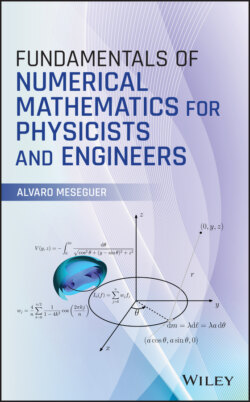Читать книгу Fundamentals of Numerical Mathematics for Physicists and Engineers - Alvaro Meseguer - Страница 20
1.6 Conditioning
ОглавлениеAs mentioned before, nonlinear equations usually involve parameters and constants coming from known external data. For example, Eq. (1.5) for the quantum energy levels depend on the well's depth and width , as well as on the mass of the particle . Therefore, it is obvious that changing the value of , , or in (1.5) will change the value of the corresponding energy levels . In particular, we may also expect that if the parameters are changed just by a tiny amount, then the changes in the solutions should also be very small.
In numerical mathematics, a problem is said to be well conditioned when small changes in the input data always lead to small changes in the output solution. By contrast, a problem is said to be ill conditioned when even very small changes in the input data may lead to very large variations in the outcome. In practice it is very important to quantify this sensitivity of the solution to small changes in the input data. Let us quantify this in the case of root‐finding.
Imagine we are asked to find the abscissa at which the graph intercepts the ordinate ; see Figure 1.3a. Mathematically, the sought abscissa is the root of the equation , where plays the role of a parameter. If is slightly changed to (with small), the new root will accordingly move to a new value . If the conditions of the inverse function theorem are satisfied in a neighborhood of , the equation defines as a function with , where is the inverse function of . Accordingly, the derivatives of at and of at satisfy the relation
(1.21)
or for short, where the prime symbols acting on and must be understood as derivatives with respect to and , respectively. We can now estimate the location of the new root. Since is small,
Since the new root is precisely located at ,
Finally, since , we conclude from the last equation that . Taking the absolute value and recalling that ,
(1.22)
This last expression predicts how far the new root will move in terms of how much we have perturbed . From (1.22), we see that no matter how tiny may be, can potentially be very large if is very small. As an example, take the equation . For , the previous equation has a simple root at and a double root at (see Figure 1.3b, black curve). For and , the simple root exhibits a slight displacement to and , respectively (see dashed and solid gray curves in Figure 1.3b, respectively). However, for the same values of , the double root does experience remarkable changes. In particular, for , the double root disappears, leading to two simple roots located at and . For the effects are even more drastic since the function has no longer any root near .
Figure 1.3 (a) Graph intercepting ordinates and at abscissas and , respectively. (b) Roots of the equation for (solid black curve), (dashed gray), and (solid gray).
From the previous analysis, we can clearly conclude that the double root is more sensitive (or ill‐conditioned) than the simple root . This phenomenon could have been predicted in advance just by evaluating the denominator appearing in (1.22) with and or , since , whereas .
In general, for a given numerical problem, it is common practice to quantify its conditioning by the simple relation
(1.23)
where and are the size of the variations introduced in the input data and their corresponding deviation effect in the outcome solution, respectively, and is a positive constant known as the condition number of the problem. The quantity may represent uncertainties in the parameters, numerical noise or, within the context of this book, numerical inaccuracies due to limited machine precision. The condition number must be understood as a noise amplifier, which magnifies small uncertainties. A condition number of order 1 is an indication of well‐conditioning, whereas a problem with is definitely ill‐conditioned.
By comparing (1.23) with (1.22), we can easily identify as the displacement exhibited by the root, as the numerical uncertainty in the evaluation of , and
(1.24)
as the condition number of the root . As we will see in Section 1.6, the performance of Newton's method can be affected if the root we are looking for is ill‐conditioned.
